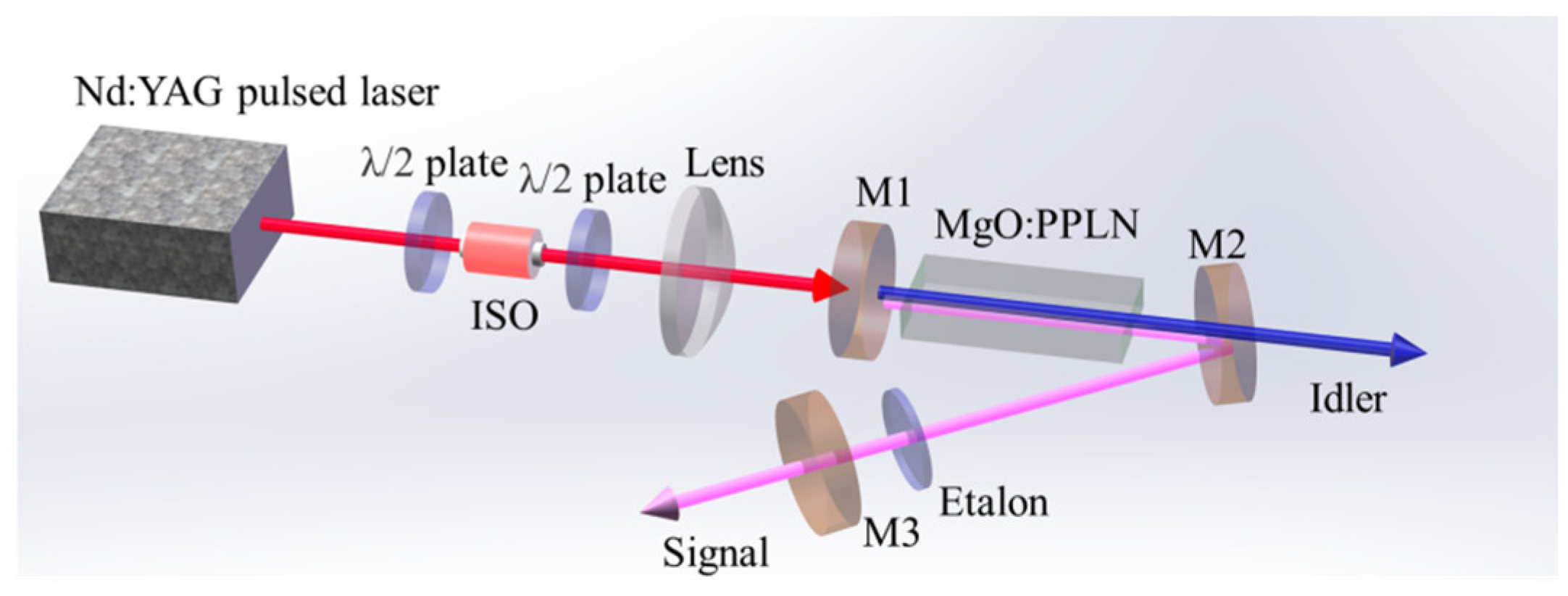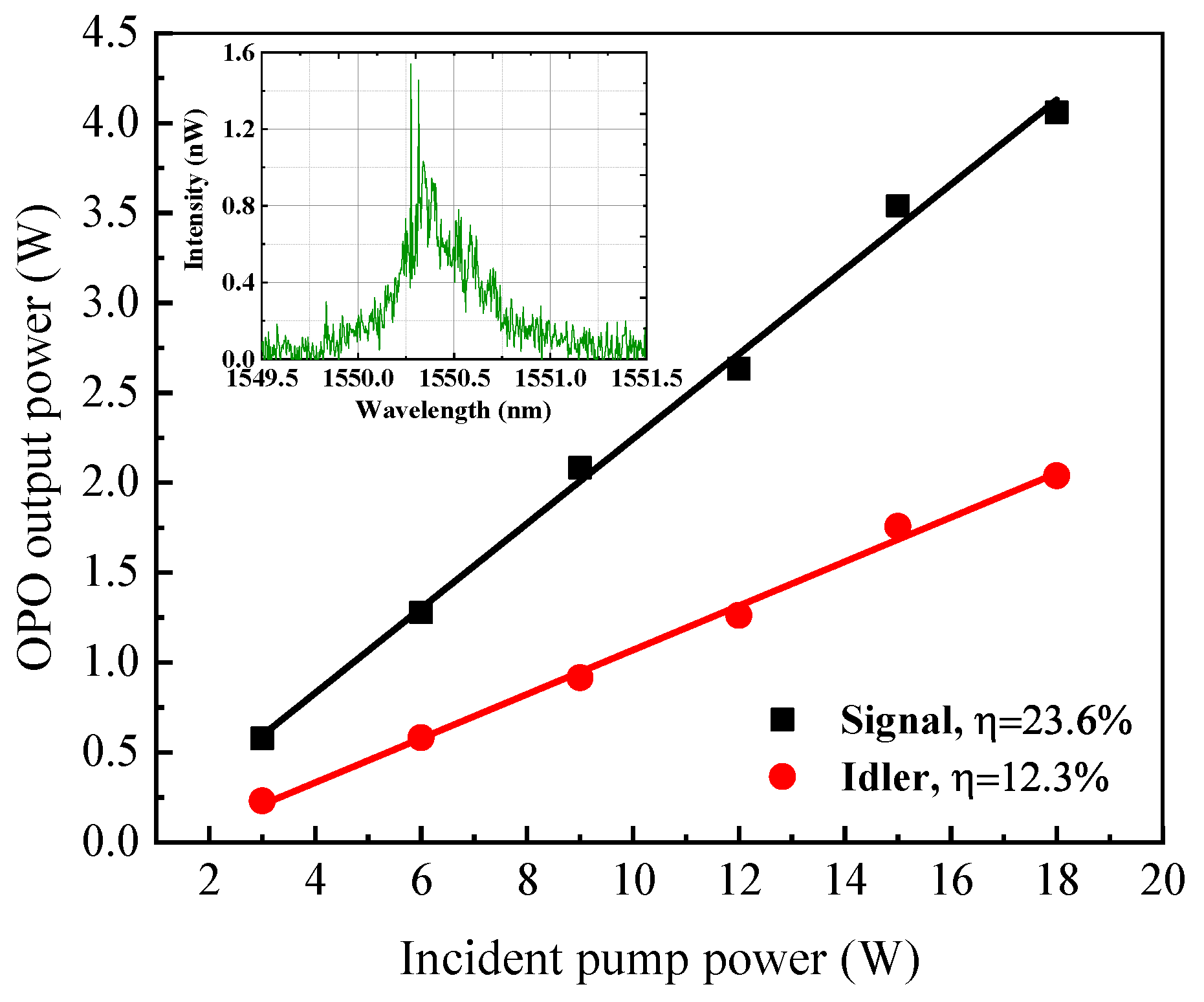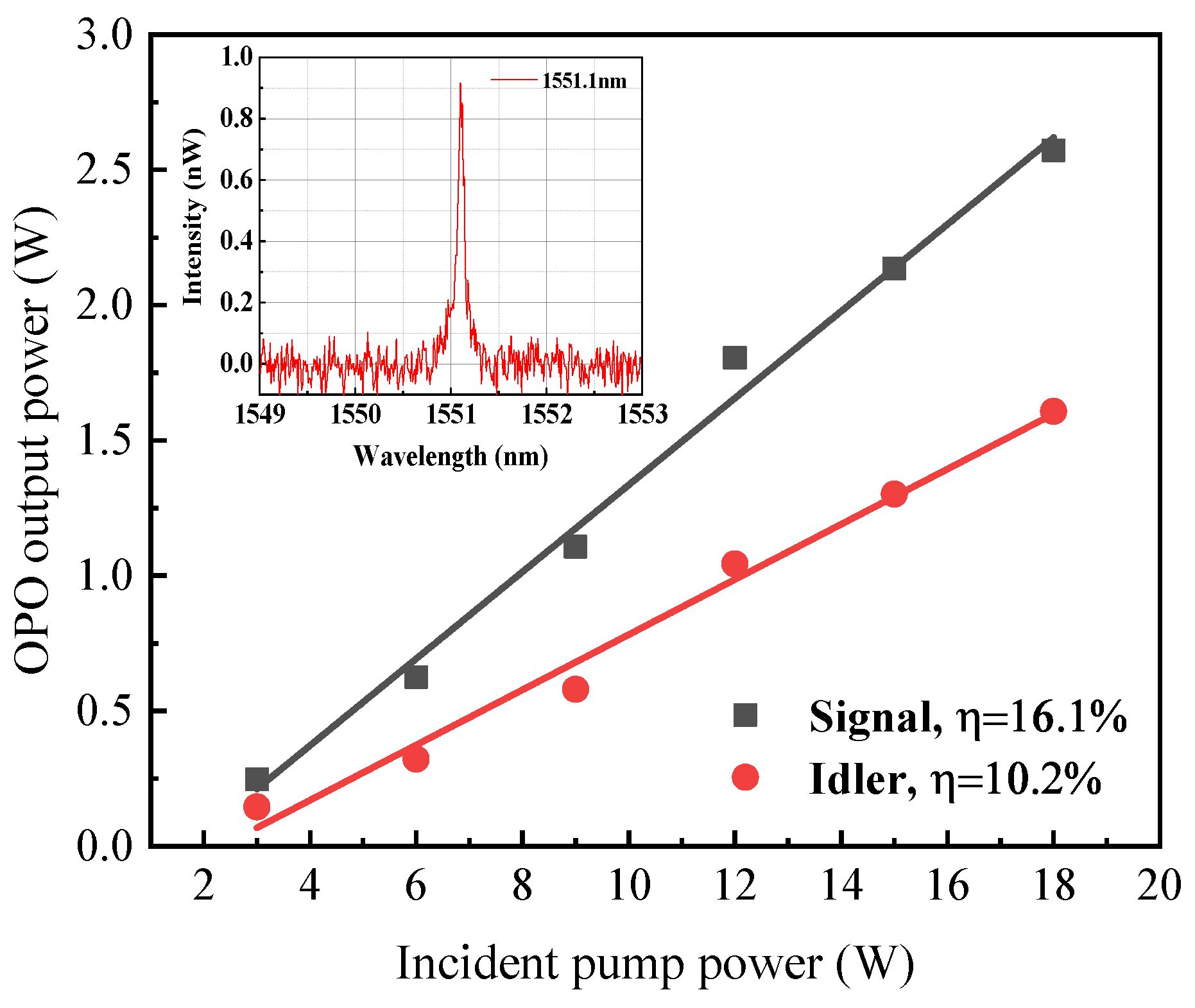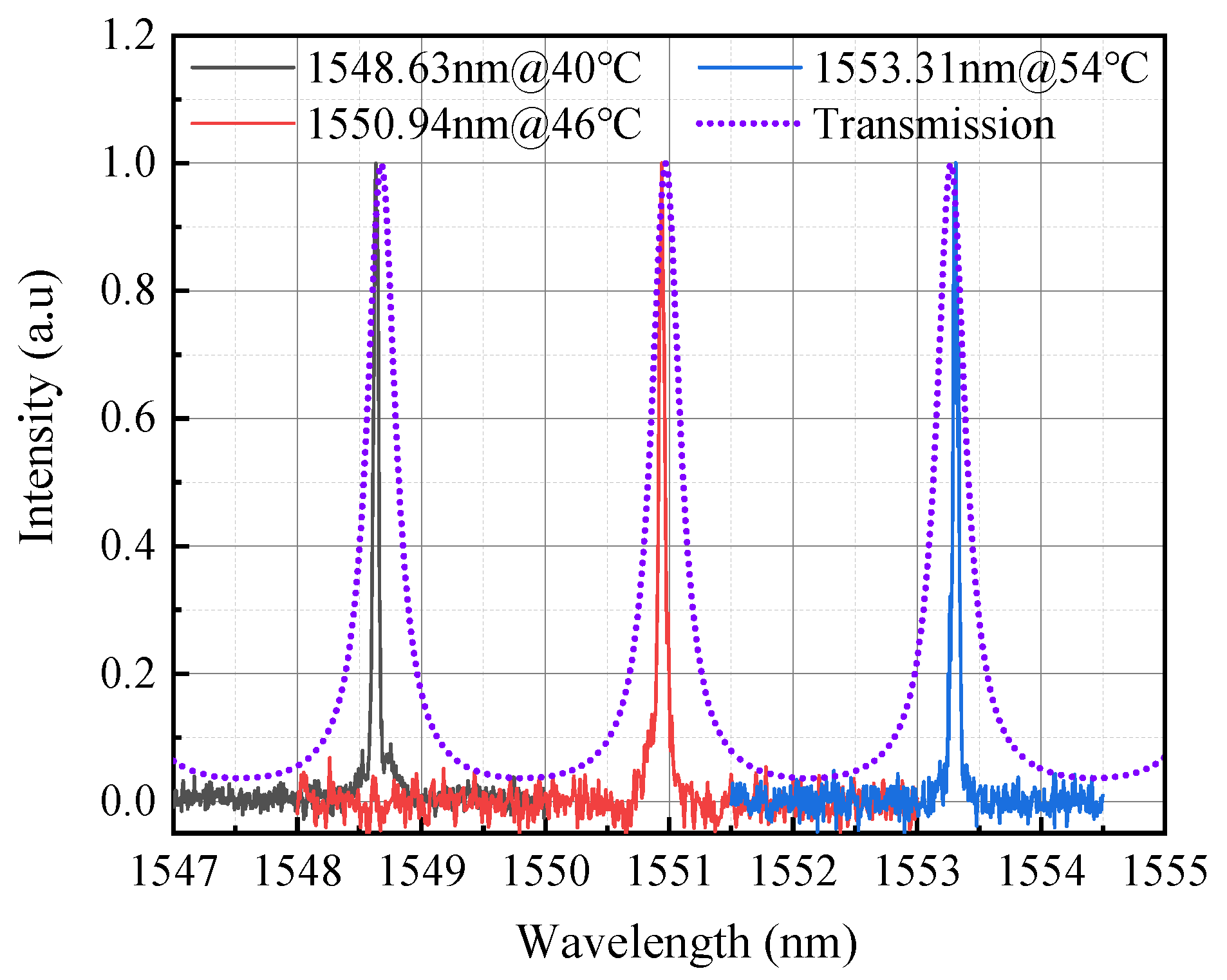1.55 μm Narrow-Linewidth Pulsed Laser Based on MgO:PPLN
Abstract
:1. Introduction
2. Experimental Setup
3. Experimental Results
4. Conclusions
Author Contributions
Funding
Institutional Review Board Statement
Informed Consent Statement
Data Availability Statement
Conflicts of Interest
References
- Päschke, E.; Leinweber, R.; Lehmann, V. An assessment of the performance of a 1.5 μm Doppler lidar for operational vertical wind profiling based on a 1-year trial. Atmos. Meas. Tech. 2015, 8, 2251–2266. [Google Scholar] [CrossRef] [Green Version]
- Qi, Y.; Bai, Z.X.; Wang, Y.L.; Zhang, X.P.; Qi, Y.Y.; Ding, J.; Bai, Z.A.; Lu, Z.W. Research progress of all-solid-state passively Q-switched Er:Yb:glass lasers. Infrared Phys. Techn. 2021, 116, 103727. [Google Scholar] [CrossRef]
- Kasmi, M.; Mrabet, H.; Mhatli, S.; Bahloul, F.; Dayoub, I.; Oh, K. Performance enhancement of 64 Gb/s OFDM system at 1550 nm over multimode fiber using Volterra equalization. Opt. Commun. 2019, 449, 86–93. [Google Scholar] [CrossRef]
- Aliee, M.; Mozaffari, M.H.; Saghaei, H. Dispersion-flattened photonic quasicrystal optofluidic fiber for telecom C band operation. Photonic. Nanostruct. 2020, 40, 100797. [Google Scholar] [CrossRef]
- Guo, L.; Li, M.; Li, T.; Zhang, S.Y.; Yang, K.J.; Fan, M.Q.; Zhao, S.Z. Inband pumped passively Q-switched Er: YAG laser at 1645 nm using WS2. Opt. Commun. 2018, 406, 230–233. [Google Scholar] [CrossRef]
- Chen, Y.H.; Huang, J.H.; Huang, Y.D.; Gong, X.H.; Lin, Y.F.; Luo, Z.D.; Chen, Y.J. Refractive index, thermal, spectroscopic and 1.55 μm laser properties of an Er: Yb: Lu2Si2O7 crystal. Opt. Mater. 2022, 128, 112448. [Google Scholar] [CrossRef]
- Peng, Y.F.; Wei, X.B.; Wang, W.M.; Li, D.M. High-power 3.8 μm tunable optical parametric oscillator based on PPMgO:CLN. Opt. Commun. 2010, 283, 4032–4035. [Google Scholar] [CrossRef]
- Peng, Y.F.; Wei, X.B.; Luo, X.W.; Nie, Z.; Peng, J.; Wang, Y.; Shen, D.Y. High-power and widely tunable mid-infrared optical parametric amplification based on PPMgLN. Opt. Lett. 2016, 41, 49–51. [Google Scholar] [CrossRef]
- Zhang, H.N.; Chen, X.H.; Wang, Q.P.; Zhang, X.Y.; Chang, J.; Gao, L.; Shen, H.B.; Cong, Z.H.; Liu, Z.J.; Tao, X.T.; et al. High-efficiency diode-pumped actively Q-switched ceramic Nd:YAG/BaWO4 Raman laser operating at 1666 nm. Opt. Lett. 2014, 39, 2649–2651. [Google Scholar] [CrossRef]
- Ma, H.J.; Wei, X.; Dai, S.B.; Yin, H.; Zhu, S.Q.; Li, Z.; Chen, Z.Q. Intra-cavity diamond Raman laser at 1634 nm. Opt. Express. 2021, 29, 31156–31163. [Google Scholar]
- Jin, H.; Liu, F.M.; Xu, P.; Xia, J.L.; Zhong, M.L.; Yuan, Y.; Zhou, J.W.; Gong, Y.X.; Wang, W.; Zhu, S.N. On-chip generation and manipulation of entangled photons based on reconfigurable lithium-niobate waveguide circuits. Phys.Rev.Lett. 2014, 113, 103601. [Google Scholar] [CrossRef] [PubMed]
- Peng, Y.F.; Wei, X.B.; Nie, Z.; Luo, X.W.; Peng, J.; Wang, Y.; Shen, D.Y. High-power, narrow-bandwidth mid-infrared PPMgLN optical parametric oscillator with a volume Bragg grating. Opt. Express. 2015, 23, 30827–30832. [Google Scholar] [CrossRef] [PubMed]
- Li, K.; Yang, S.H.; Wang, X.; Li, Z.; Zhang, J.Y. Frequency Chirped Intensity Modulated Mid-Infrared Light Source Based on Optical Parametric Oscillation. IEEE Photonics J. 2020, 12, 1–9. [Google Scholar] [CrossRef]
- Zhao, J.Q.; Cheng, P.; Xu, F.; Zhou, X.F.; Tang, J.; Liu, Y.; Wang, G.D. Watt-level continuous-wave single-frequency mid-infrared optical parametric oscillator based on MgO:PPLN at 3.68 µm. Appl. Sci. 2018, 8, 1345. [Google Scholar] [CrossRef] [Green Version]
- Xing, T.L.; Wang, L.; Hu, S.W.; Cheng, T.Q.; Wu, X.Y.; Jiang, H.H. Widely tunable and narrow-bandwidth pulsed mid-IR PPMgLN-OPO by self-seeding dual etalon-coupled cavities. Opt. Express. 2017, 25, 31810–31815. [Google Scholar] [CrossRef]
- Peng, Y.F.; Wei, X.B.; Xie, G.; Gao, J.R.; Li, D.M.; Wang, W.M. A high-power narrow-linewidth optical parametric oscillator based on PPMgLN. Laser Phys. 2013, 23, 055405. [Google Scholar] [CrossRef]
- Guo, L.; Yang, Y.Y.; Xu, H.P.; Kong, H.; Lv, G.R.; Wen, J.Q.; Bian, J.T.; Ye, Q.; Sun, X.Q.; Yang, K.J. High power linearly polarized diode-side-pumped Nd: YAG laser based on an asymmetric flat–flat resonator with the variable working point. Opt. Commun. 2022, 520, 128453. [Google Scholar] [CrossRef]
- Gayer, O.; Sacks, Z.; Galun, E.; Arie, A. Temperature and wavelength dependent refractive index equations for MgO-doped congruent and stoichiometric LiNbO3. Appl. Phys. B. 2008, 91, 343–348. [Google Scholar] [CrossRef]
- Xu, L.; Zhang, S.Y.; Chen, W.B. Tm:YLF laser-pumped periodically poled MgO-doped congruent LiNbO3 crystal optical parametric oscillators. Opt. Lett. 2012, 37, 743–745. [Google Scholar] [CrossRef]
- Liu, J.L.; Chen, X.Y.; Wang, R.M.; Wu, C.T.; Jin, G.Y. A stable wavelength operation Ho:YAG laser with orthogonally polarized pump. Chinese Phys. Lett. 2019, 36, 024201. [Google Scholar] [CrossRef]
- Ahmad, H.; Muhamad, A.; Sharbirin, A.S.; Samion, M.Z.; Ismail, M.F. Tunable Q-switched thulium-doped Fiber Laser using multiwall carbon nanotube and Fabry-Perot Etalon filter. Opt. Commun. 2017, 383, 359–365. [Google Scholar] [CrossRef]






| Mirror | Radius | Coating |
|---|---|---|
| M1 | Infinity | AR@1.064 μm, 3.4–4.3 μm, and HR@1.4–1.6 μm |
| M2 | −500 mm | HR@1.4–1.6 µm, HT@1.064 μm, and 3.4–4.3 μm |
| M3 | Infinity | T = 10%@1.4–1.6 µm |
Disclaimer/Publisher’s Note: The statements, opinions and data contained in all publications are solely those of the individual author(s) and contributor(s) and not of MDPI and/or the editor(s). MDPI and/or the editor(s) disclaim responsibility for any injury to people or property resulting from any ideas, methods, instructions or products referred to in the content. |
© 2023 by the authors. Licensee MDPI, Basel, Switzerland. This article is an open access article distributed under the terms and conditions of the Creative Commons Attribution (CC BY) license (https://creativecommons.org/licenses/by/4.0/).
Share and Cite
Yang, Y.; Lv, G.; Guo, L.; Xu, H.; Kong, H.; Wen, J.; Bian, J.; Ye, Q.; Yang, K.; He, J. 1.55 μm Narrow-Linewidth Pulsed Laser Based on MgO:PPLN. Photonics 2023, 10, 77. https://doi.org/10.3390/photonics10010077
Yang Y, Lv G, Guo L, Xu H, Kong H, Wen J, Bian J, Ye Q, Yang K, He J. 1.55 μm Narrow-Linewidth Pulsed Laser Based on MgO:PPLN. Photonics. 2023; 10(1):77. https://doi.org/10.3390/photonics10010077
Chicago/Turabian StyleYang, Yaling, Guorui Lv, Lei Guo, Haiping Xu, Hui Kong, Jiaqi Wen, Jintian Bian, Qing Ye, Kejian Yang, and Jingliang He. 2023. "1.55 μm Narrow-Linewidth Pulsed Laser Based on MgO:PPLN" Photonics 10, no. 1: 77. https://doi.org/10.3390/photonics10010077
APA StyleYang, Y., Lv, G., Guo, L., Xu, H., Kong, H., Wen, J., Bian, J., Ye, Q., Yang, K., & He, J. (2023). 1.55 μm Narrow-Linewidth Pulsed Laser Based on MgO:PPLN. Photonics, 10(1), 77. https://doi.org/10.3390/photonics10010077






